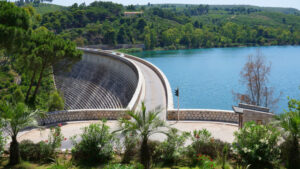Emergency measures to address water scarcity and climate risks are being activated by EYDAP to address the rapid decline in reservoir supplies and the increased demand for water brought on by severe drought and rapidly rising temperatures.
According to the presentation made yesterday at the regular general meeting of shareholders by CEO Mr. Haris Sachinis, water extraction from Yliki begins these days, while up to 17 boreholes in Mavrosouvala, as well as the boreholes of the middle course of the Boeotian Kifisos, are being put into full mobilization, with expenses largely covered by EYDAP Pagon. These measures are supported by EYDAP’s water-saving campaign “Want water? Turn off the tap,” as the goal is rational water use rather than waste.
However, the EYDAP has also worked out alternative plans depending on the picture for the next hydrological seasons, which is from September to March. With the current data, there are water reserves for at least three years, as Mr. Sahinis said yesterday.
But other solutions are also on the table, such as the inclusion of new reservoirs in the water supply system, the enrichment of the underground aquifer with recycled water from the Wastewater Treatment Centres and desalination, at an estimated cost of between €500 million and €750 million.
Desalination
Regarding desalination, Sahinis said yesterday that although they have high energy costs, it is a model that can help and that is why they are already looking at 4-5 areas where the company could proceed with similar measures. At the same time, EYDAP has started working on a master plan on the recycled water needs in the greater capital region.
Yesterday, the head of EYDAP also presented an alternative proposal to shareholders, saying that among the upcoming solutions could be “merging” through the Eynos and Mornos tunnels and other tributaries connected to Lake Kremasta. As he had recently said in Parliament, the possibility of extending, as has already been done from the Mornos, with a 30-kilometer tunnel, to the Eynos is being considered, given that 10 km further on there is a tributary that flows into Lake Cremasta and another 10 km further on there is another tributary. From these tributaries the water can be brought to the Evinos by gravity, reducing energy costs.
Ask me anything
Explore related questions





